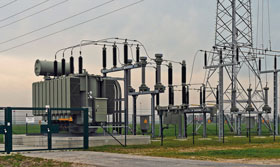

Power transformers are generally regarded as ‘safe’ pieces of equipment. However, in practice, they can present some quite serious risks. This is due to the large quantities of oil that they contain which is in contact with the high voltage elements. As a consequence of temperature changes and in many cases overheating of the transformer core, various gases can be generated within the transformer oil system. These will tend to accumulate in the space above the oil in the reservoir – which is usually filled with nitrogen. The gases generated include several hydrocarbons and also hydrogen.
During daytime hours the increase in temperature causes the gas space pressure to increase while at the same time the oil expands. Some of this gas dissolves in the oil. During the night, the process reverses: the temperature drops, the oil contracts and the gas space pressure drops. Ideally, all the excess gas would return to the gas space, but frequently an excess remains in the oil which is then considered to be supersaturated. Any mechanical disturbance such as the sudden starting of a pump, a lightning strike, or movement within the windings as a result of a sudden large increase in current, could release the excess gas as bubbles in the oil.
Typical gases that appear in transformers are hydrogen, methane, ethane, ethylene and acetylene. These begin to form at specific temperatures and dissolve within the insulation oil of a power transformer. The types and quantities of the gases that form will depend on the nature of the conditions. The first to appear are hydrogen and methane, which begin to form in small amounts at around 150°C. Thermal decomposition of cellulose materials begins at about 100°C and these processes produce hydrogen, carbon monoxide, carbon dioxide, methane and oxygen. This is a compelling reason why transformers should not be operated above 90°C.
Explosion risk and the Gen5 System
A large percentage of transformer failures are caused by ignition and explosion of these gases. Dissolved gas analysis (DGA) should therefore be a primary maintenance routine for transformer operators. Traditionally, this is carried out by technicians that visit transformers on a regular basis and carry out tests to identify the presence of gases dissolved in the transformer oil. This is an expensive and frequently unreliable procedure. Due to the decreased availability of personnel taking DGA samples – a situation aggravated by the COVID-19 pandemic – many utilities now choose real-time monitoring of transformer dissolved gases.
RTS Africa Technologies (RTS) is able to provide DGA analytical instruments designed specifically for real-time monitoring of hydrogen in transformer oil systems.
Tshwane-based RTS is an agent for US-based H2scan, a leading provider of hydrogen sensors and technologies for utilities, which recently announced the increased availability of its Gen5 System, developed specifically for transformer oil DGA and monitoring.
The Gen5 System enables real-time hydrogen monitoring for reduced risk of explosion and catastrophic failure and is ideal for use in distribution transformer applications, including those located in populated areas such as suburbs, under streets and in industrial sites. The system delivers high accuracy sensing at an affordable price with over 15 000 units already installed.
The sensor system works with oil immersed transformers and offers real-time, or step-change monitoring to report hydrogen levels as they fluctuate. It can track hydrogen levels in the transformer oil from 25 ppm to 5000 ppm at oil temperatures up to 105°C. The real-time monitoring is ideal for smaller transformers where power overloads can cause higher temperatures that quickly drive up hydrogen levels.
The Gen5 System incorporates H2scan’s patented auto-calibration technology, requiring no maintenance or recalibration for up to 10 years. Total install or retrofit time is less than one hour. The instrument is IP68 rated and can withstand 14 days submersion in water to a depth of up to 10 metres, making it ideal for underground vault transformers. In the midst of the COVID-19 pandemic, the Gen5 System is a game changer for utilities wanting to eliminate manual sampling and substation visits by maintenance crews.
| Email: | [email protected] |
| www: | www.rtsafrica.co.za |
| Articles: | More information and articles about RTS Africa Engineering |

© Technews Publishing (Pty) Ltd | All Rights Reserved